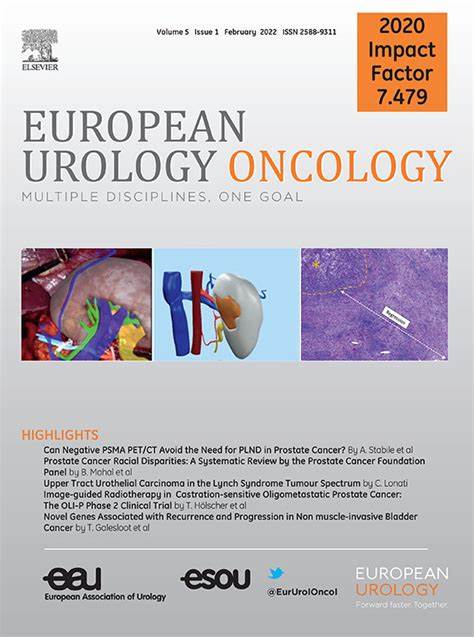Assessment of the Prognostic and Predictive Values of the Deficient Mismatch Repair Phenotype in Patients Treated with Radical Nephroureterectomy for Upper Tract Urothelial Carcinoma
IF 9.3
1区 医学
Q1 ONCOLOGY
引用次数: 0
Abstract
Background and objective
Given the conflicting evidence currently available in the literature, our aim was to assess the prognostic and predictive values of the deficient mismatch repair (dMMR) phenotype in a large cohort of upper tract urothelial carcinoma (UTUC) patients.
Methods
Based on our national network, we performed a retrospective multicenter study including 281 UTUC patients treated with radical nephroureterectomy between 2000 and 2015 at ten French hospitals. The dMMR phenotype as well as PD-L1 and PD-1 expression were determined using immunohistochemistry analyses based on 2-mm-core tissue microarrays. Multivariable Cox regression models were fitted to assess the impact of the dMMR phenotype on recurrence-free (RFS), cancer-specific (CSS), and overall (OS) survival using interaction terms to test the heterogeneity of the treatment effect of adjuvant chemotherapy (AC). Multivariable logistic regression models were also fitted to assess the impact of the dMMR phenotype on PD-L1 and PD-1 expression.
Key findings and limitations
Overall, 76 (27.0%) patients had a dMMR phenotype, which was an independent predictor of prolonged RFS (hazard ratio [HR] = 0.41; 95% confidence interval [CI] = [0.21–0.83]; p = 0.01), CSS (HR = 0.38; 95% CI = [0.18–0.83]; p = 0.02), and OS (HR = 0.44; 95% CI = [0.22–0.89]; p = 0.02), with a significant interaction with the use of AC in multivariable Cox regression models (all pinteraction < 0.05). Subgroup analyses showed that the use of AC was significantly associated with prolonged RFS (HR = 0.14; 95% CI = [0.06–0.30]; p < 0.001), CSS (HR = 0.10; 95% CI = [0.03–0.29]; p < 0.001), and OS (HR = 0.23; 95% CI = [0.10–0.54]; p = 0.001) in non-dMMR patients only, without any significant benefit in dMMR patients (all p > 0.05). In multivariable logistic regression analyses, the dMMR phenotype was significantly associated with inverse PD-L1 (OR = 0.20; 95% CI = [0.10–0.80]; p = 0.001) and PD-1 (OR = 0.36; 95% CI = [0.16–0.79]; p = 0.01) expression.
Conclusions and clinical implications
We observed that the dMMR phenotype was associated with favorable pathological characteristics and prognosis in UTUC patients, despite conferring decreased sensitivity to AC and lower PD-L1 or PD-1 expression.
上尿路上皮癌根治性肾输尿管切除术患者错配修复表型缺陷的预后和预测价值评估。
背景和目的:鉴于目前文献中存在的相互矛盾的证据,我们的目的是评估大量上尿路上皮癌(UTUC)患者中缺陷错配修复(dMMR)表型的预后和预测价值。方法:基于我们的国家网络,我们进行了一项回顾性多中心研究,包括2000年至2015年在法国10家医院接受根治性肾输尿管切除术的281例UTUC患者。采用基于2mm核组织微阵列的免疫组织化学分析测定dMMR表型以及PD-L1和PD-1的表达。多变量Cox回归模型拟合评估dMMR表型对无复发(RFS)、癌症特异性(CSS)和总(OS)生存的影响,使用相互作用项来检验辅助化疗(AC)治疗效果的异质性。还拟合了多变量logistic回归模型来评估dMMR表型对PD-L1和PD-1表达的影响。主要发现和局限性:总体而言,76例(27.0%)患者具有dMMR表型,这是延长RFS的独立预测因子(风险比[HR] = 0.41;95%置信区间[CI] = [0.21-0.83];p = 0.01), CSS (HR = 0.38;95% ci = [0.18-0.83];p = 0.02), OS (HR = 0.44;95% ci = [0.22-0.89];p = 0.02),与多变量Cox回归模型中AC的使用有显著的交互作用(所有p交互作用< 0.05)。亚组分析显示,AC的使用与延长RFS显著相关(HR = 0.14;95% ci = [0.06-0.30];p < 0.001), CSS (HR = 0.10;95% ci = [0.03-0.29];p < 0.001), OS (HR = 0.23;95% ci = [0.10-0.54];p = 0.001), dMMR患者无显著获益(均p = 0.05)。在多变量logistic回归分析中,dMMR表型与PD-L1逆相关(OR = 0.20;95% ci = [0.10-0.80];p = 0.001)和PD-1 (OR = 0.36;95% ci = [0.16-0.79];P = 0.01)表达。结论和临床意义:我们观察到dMMR表型与UTUC患者良好的病理特征和预后相关,尽管其对AC的敏感性降低,PD-L1或PD-1表达降低。
本文章由计算机程序翻译,如有差异,请以英文原文为准。
求助全文
约1分钟内获得全文
求助全文
来源期刊

European urology oncology
Multiple-
CiteScore
15.50
自引率
2.40%
发文量
128
审稿时长
20 days
期刊介绍:
Journal Name: European Urology Oncology
Affiliation: Official Journal of the European Association of Urology
Focus:
First official publication of the EAU fully devoted to the study of genitourinary malignancies
Aims to deliver high-quality research
Content:
Includes original articles, opinion piece editorials, and invited reviews
Covers clinical, basic, and translational research
Publication Frequency: Six times a year in electronic format
 求助内容:
求助内容: 应助结果提醒方式:
应助结果提醒方式:


